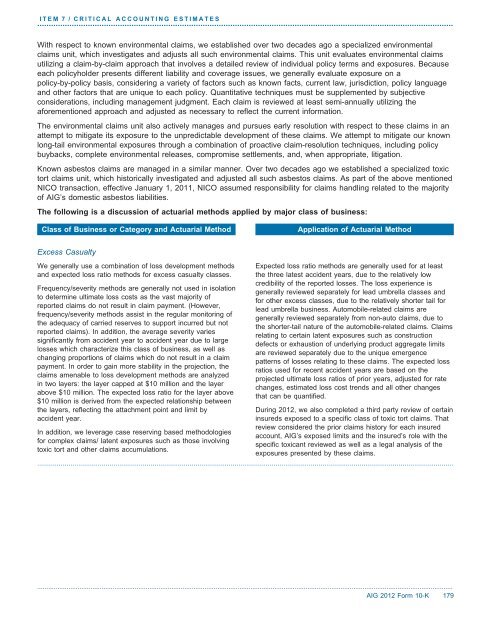Bring on tomorrow - AIG.com
Bring on tomorrow - AIG.com
Bring on tomorrow - AIG.com
You also want an ePaper? Increase the reach of your titles
YUMPU automatically turns print PDFs into web optimized ePapers that Google loves.
ITEM 7 / CRITICAL ACCOUNTING ESTIMATES.....................................................................................................................................................................................With respect to known envir<strong>on</strong>mental claims, we established over two decades ago a specialized envir<strong>on</strong>mentalclaims unit, which investigates and adjusts all such envir<strong>on</strong>mental claims. This unit evaluates envir<strong>on</strong>mental claimsutilizing a claim-by-claim approach that involves a detailed review of individual policy terms and exposures. Becauseeach policyholder presents different liability and coverage issues, we generally evaluate exposure <strong>on</strong> apolicy-by-policy basis, c<strong>on</strong>sidering a variety of factors such as known facts, current law, jurisdicti<strong>on</strong>, policy languageand other factors that are unique to each policy. Quantitative techniques must be supplemented by subjectivec<strong>on</strong>siderati<strong>on</strong>s, including management judgment. Each claim is reviewed at least semi-annually utilizing theaforementi<strong>on</strong>ed approach and adjusted as necessary to reflect the current informati<strong>on</strong>.The envir<strong>on</strong>mental claims unit also actively manages and pursues early resoluti<strong>on</strong> with respect to these claims in anattempt to mitigate its exposure to the unpredictable development of these claims. We attempt to mitigate our knownl<strong>on</strong>g-tail envir<strong>on</strong>mental exposures through a <strong>com</strong>binati<strong>on</strong> of proactive claim-resoluti<strong>on</strong> techniques, including policybuybacks, <strong>com</strong>plete envir<strong>on</strong>mental releases, <strong>com</strong>promise settlements, and, when appropriate, litigati<strong>on</strong>.Known asbestos claims are managed in a similar manner. Over two decades ago we established a specialized toxictort claims unit, which historically investigated and adjusted all such asbestos claims. As part of the above menti<strong>on</strong>edNICO transacti<strong>on</strong>, effective January 1, 2011, NICO assumed resp<strong>on</strong>sibility for claims handling related to the majorityof <strong>AIG</strong>’s domestic asbestos liabilities.The following is a discussi<strong>on</strong> of actuarial methods applied by major class of business:Class of Business or Category and Actuarial MethodApplicati<strong>on</strong> of Actuarial MethodExcess CasualtyWe generally use a <strong>com</strong>binati<strong>on</strong> of loss development methods Expected loss ratio methods are generally used for at leastand expected loss ratio methods for excess casualty classes. the three latest accident years, due to the relatively lowcredibility of the reported losses. The loss experience isFrequency/severity methods are generally not used in isolati<strong>on</strong>generally reviewed separately for lead umbrella classes andto determine ultimate loss costs as the vast majority offor other excess classes, due to the relatively shorter tail forreported claims do not result in claim payment. (However,lead umbrella business. Automobile-related claims arefrequency/severity methods assist in the regular m<strong>on</strong>itoring ofgenerally reviewed separately from n<strong>on</strong>-auto claims, due tothe adequacy of carried reserves to support incurred but notthe shorter-tail nature of the automobile-related claims. Claimsreported claims). In additi<strong>on</strong>, the average severity variesrelating to certain latent exposures such as c<strong>on</strong>structi<strong>on</strong>significantly from accident year to accident year due to largedefects or exhausti<strong>on</strong> of underlying product aggregate limitslosses which characterize this class of business, as well asare reviewed separately due to the unique emergencechanging proporti<strong>on</strong>s of claims which do not result in a claimpatterns of losses relating to these claims. The expected losspayment. In order to gain more stability in the projecti<strong>on</strong>, theratios used for recent accident years are based <strong>on</strong> theclaims amenable to loss development methods are analyzedprojected ultimate loss ratios of prior years, adjusted for ratein two layers: the layer capped at $10 milli<strong>on</strong> and the layerchanges, estimated loss cost trends and all other changesabove $10 milli<strong>on</strong>. The expected loss ratio for the layer abovethat can be quantified.$10 milli<strong>on</strong> is derived from the expected relati<strong>on</strong>ship betweenthe layers, reflecting the attachment point and limit byDuring 2012, we also <strong>com</strong>pleted a third party review of certainaccident year.insureds exposed to a specific class of toxic tort claims. Thatreview c<strong>on</strong>sidered the prior claims history for each insuredIn additi<strong>on</strong>, we leverage case reserving based methodologiesaccount, <strong>AIG</strong>’s exposed limits and the insured’s role with thefor <strong>com</strong>plex claims/ latent exposures such as those involvingspecific toxicant reviewed as well as a legal analysis of thetoxic tort and other claims accumulati<strong>on</strong>s.exposures presented by these claims........................................................................................................................................................................................................................................................................................................................................................................................................................................................<strong>AIG</strong> 2012 Form 10-K 179
















